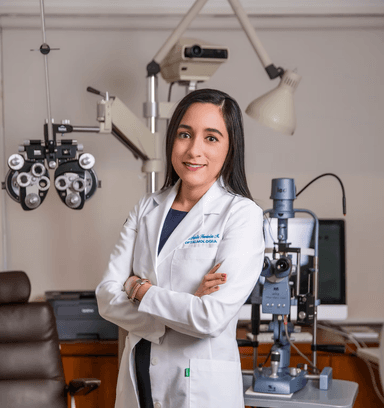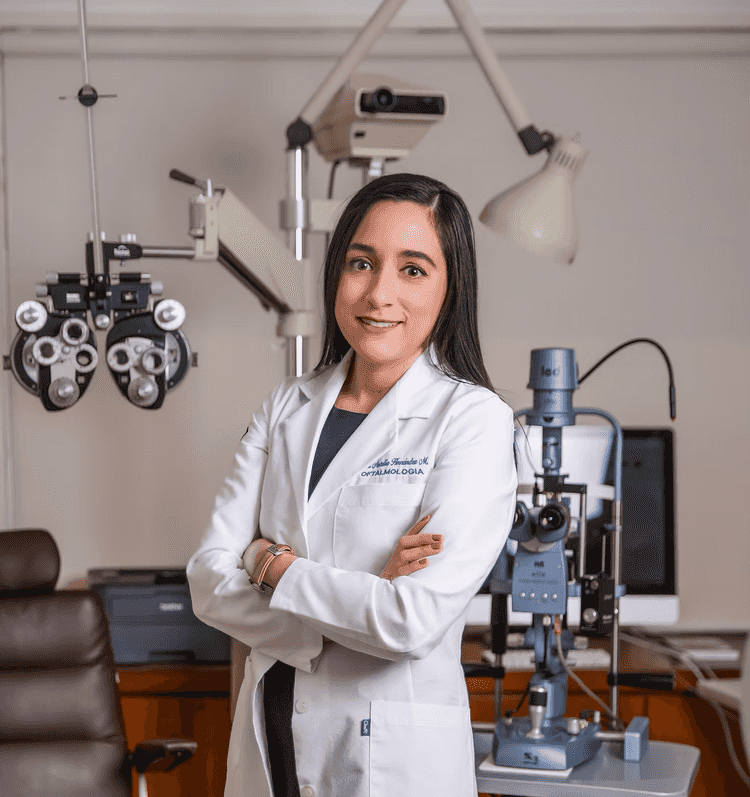Training Eyes After Cataract Surgery: Exercises and Tips for Faster Recovery

Prathyusha Itikarlapalli
- Content Writer

Dr. Natalia Hernandez Martinez
- Reviewed by

Key Takeaways
- Training eyes after cataract surgery makes a difference, as the brain and eyes need to adjust to the newly implanted IOL. The IOL refracts light clearly, so the brain should relearn visual processing, color, and depth perception.
- Training eyes does not mean physical training. Patients should actively view near and far objects, shift focus between both, trace the horizon, and work on color and light perception.
- After surgery, patients see a clear vision within 24 hours with slight discomfort, hazy eyesight, difficulty with night vision, and light sensitivity. These subsides gradually, and vision stabilizes within 12 months, which is referred to as complete healing after cataract surgery.
Cataract Eye Surgery
More than 26 million cataract eye surgeries are performed annually worldwide.[1] Cataract eye surgery is one of the most commonly performed surgical eye procedures due to its high success rate. Cataracts begin as tiny white dots in the eye lens, causing blurry vision, which can even lead to complete blindness in advanced stages. These are more prevalent in aged seniors. However, this does not mean it's restricted to the elderly.[2] Although the incidence is relatively low, even youngsters and children are prone to cataracts.[3]
The clear, transparent natural lens develops a dense, white cataract due to abnormal protein breakage and its buildup. Eyelens in a healthy eye bends light rays so they fall on the retina, which we see as the object. However, dense cataracts obstruct the light significantly, causing vision problems that last for a lifetime. Ophthalmologists remove the dense cataract surgically and implant an intraocular lens to attain normal vision.
Do Eyes Look Different After Cataract Surgery?
Cataract surgery does not noticeably change the physical appearance of the eye unless the cataracts are too dense and opaque. The eye color, shape, size, and other external features remain unchanged, as the surgery only involves small slits to replace the clouded cataract with a clear IOL. Less severe yet immediate effects like redness and swelling are common. Note that these gradually reduce on their own, and your eyes physically look more or less the same as they are.
Eyes Adjusting After Cataract Surgery: What Does It Mean?
The eye surgeons replace the cataract and implant an artificial lens to restore clear vision. Intraocular lenses vary with the vision requirements and patient preferences. These refract light differently. Stepping deeper, the artificial intraocular lens produces sharper images that are in contrast to the hazy, blurred images produced by cataract formed eyelens prior to the surgery. While the eyelens refracts light based on its ability, your brain needs to adapt itself to the new lens. Furthermore, cataracts develop gradually, and your brain adapts accordingly. So, when there is a sudden clarity in vision due to the implanted IOL, your brain should adapt to this.
Experts call it neuroadaptation. It means your brain should relearn to process eyesight and interpret it accurately in terms of visual processing, color, depth recognition, and perception. More importantly, the intraocular lenses vary slightly. We will brief you on them below.
- Monofocal lenses: These lenses offer a clear vision for a single distance. Usually, it's a clear far vision. Candidates will still need glasses for reading or screen-based work.
- Multifocal lenses: These lenses adjust to multiple distances, providing crystal-clear near and far eyesight and eliminating the need for reading glasses.
- Toric lens: These lenses correct the vision problems of cataracts and corneal refractive errors, specifically astigmatism. The toric lens has different refractive powers in different meridians, which allows it to correct the irregular curvature of the cornea, which is the main cause of astigmatism.[4]
- Accommodative lens: These advanced lenses mimic the natural lens by moving or changing shape to focus on nearby and far away objects. This lens holds a flexible design that responds to eye muscle contraction and focuses accordingly.[5]

Since cataract eye surgery is performed only once, the choice of artificial lens matters significantly. The type of IOL depends on the preexisting eye conditions, the patient’s expectations regarding dependence on glasses, and cost considerations. In general, the toric, multifocal, and accommodative IOLs are considered premium options. The insurance plans limit their coverage to the standard lens choices, like the monofocal IOLs. Choosing premium lenses amounts to out-of-pocket expenses.[6]
How Long Does It Take for Your Eyes To Adjust After Cataract Surgery?
While most patients see clearly within 24 hours of cataract surgery, the complete recovery takes 4-6 weeks. Initially, it's common to experience mild discomfort, blurry vision, and light sensitivity. These subsides slowly as your eyes heal and get back to normal. You are required to follow a specific aftercare routine. While cataract surgery is generally safe, caring properly for your eyes can help you achieve optimal and lasting results. In short, training your eyes after cataract surgery is crucial for better outcomes. It helps your eyes to adapt to near and far vision quickly, so you don’t face the issues of blurry vision.
Can I Do Eye Exercises After Cataract Surgery?
Eye exercises after cataract surgery are unlike physical training for your muscles. You should include simple exercises that will train your brain on long and short-distance objects. It's worth mentioning that the best exercise after cataract surgery will speed up the eye-brain link for visual processing. They help you attain better eyesight within the best possible time. Here are a few important things to do as part of vision training after cataract surgery.
Active Viewing for Near Vision
Use your new lens to view the external world around you consciously. Start slowly and actively observe objects before making your way to complex spreadsheets or office work. Engage in activities like reading, playing cards, solving crosswords, Sudoku, word searches, and watching TV. Remember to offer short breaks for your eyes while you actively engage during the initial weeks. After all, your eyes are still healing.
Focusing on Distant Objects
Go for short walks in your neighborhood and look at the surroundings and far-off things. Gradually work this out during the day and night. Driving is a great way to train your eyes and brain for distant vision. However, ensure your ophthalmologist has approved you to perform driving.
Work Out on Light and Color Perception
Take nature walks to nearby parks and visit art galleries or museums. Focus on colors, their rich details, and vibrance. While this stimulates your brain, it also calms your mind and lifts your mood, supporting a more holistic recovery.
Shift Focus From Near to Far Objects and Vice Versa
Sit in a comfortable position in front of a window or a balcony and focus on a nearby object like a book or your finger. Then, slowly shift focus to a distant object like a tree, a house, or someone walking down the lane. Doing this will train your brain to adapt to the transition from focusing on near and far-off objects. Continue it a few more times and perform this and vice versa.
Note that you need to provide adequate rest for your eyes in order to reap the neuroadaptation benefits. Your eyes are still healing, so offer frequent breaks as you work out on various aspects of vision.
How Long After Cataract Surgery Does Your Eyes Feel Normal?
While some patients feel normal within a few months, others need a year to feel normal after cataract eye surgery. Cataract surgery offers clear vision on the day after the procedure. However, it's common for patients to experience mild discomfort, redness, and light sensitivity. Ophthalmologists make surgical incisions to remove the dense cataracts, and the eye tissues require time to heal. Patients experience symptoms of blurry vision for a few days, which usually subside. The surgery impacts the nerves involved with the tear film, and hence, patients feel dry eye symptoms. Besides, cataract surgery involves placing a new lens to replace the opaque cataract. The new IOL is crystal clear, allowing more light to enter the eye, which is why patients often see light sensitivity. Further, cataract surgery also causes changes in pupil size, which is another contributing factor to light sensitivity.[7] The complete healing of eye tissues will reduce inflammation and relieve the symptoms of dryness, light sensitivity, redness, and discomfort. Following a few dos and don’ts will help you feel normal after cataract eye surgery.
Caring for Your Eyes After Cataract Eye Surgery
Ophthalmologists suggest a few strict dos to help your eyes heal better.
- Use artificial tears to treat dry eyes. They serve as a lubricating agent, prevent infection, and make you feel comfortable as your eyes heal. These conventional eye drops require you to stick to the prescribed schedule for eyedrop usage. An easier alternative is cataract surgery without eye drops. It eliminates the repeated doses of eye drops following surgery. The one-time medicine contains antibiotics and steroids capable of clearing the infection and providing optimal conditions for your eyes as they heal.
- To deal with light sensitivity, avoid bright lights and direct exposure to sunlight. Wearing dark colored sunglasses will not only protect your eyes from harmful sun rays and dust but also help avoid unnecessary exposure to sunlight.
- While redness after cataract eye surgery occurs due to inflammation or broken blood vessels, providing adequate rest will allow the tissues to heal.

Don’ts After Cataract Eye Surgery
The following is a strict no-no after cataract eye surgery.
- Do not rub your eyes, even when they are itchy. Rubbing your eyes immediately after cataract surgery is strictly not recommended. Ophthalmologists advise wearing a protective shield while sleeping to avoid rubbing against the eyes, as it may disrupt healing and cause infections. If you ask us, “Can you rub your eyes months after cataract surgery?” Yes, if you are gentle and do it with clean hands. The eye tissues heal initially within a couple of months, and gentle rubbing a few months after cataract surgery does not potentially harm, provided the hands are clean.
- Avoid strenuous activities after cataract eye surgery. Intense exercises or physical work increase blood pressure within the eye, maximizing the chances for post-cataract complications.
- Avoid swimming and hot tubs to prevent infections or delayed healing. Water harbors bacteria, and a slight entry into the eyes can cause serious infections, worsening the post-surgical complications.
Is It Better To Be Nearsighted or Far-sighted After Cataract Surgery?
There is no predefined better option for eyesight after cataract eye surgery, whether being far-sighted or near-sighted, is case-dependent. A few candidates see near-sighted issues, while a few see far-sighted problems. However, some patients see issues of monovision, that is, at a specific distance. This is more common in individuals with monofocal IOLs. Either of the conditions can be disturbing to some extent. It's crucial to discuss your goals and problems with your ophthalmologist transparently prior to the surgery.
Loss of Near Vision After Cataract Surgery
Losing near vision after cataract surgery is a common side effect. Swelling and inflammation following cataracts are common and can cause temporary blurry vision following cataract eye surgery. However, these post-surgical symptoms gradually subside with time. A persisting near-vision loss after cataract surgery can be due to more serious causes. Here we listed a few possible causes:
- The implanted artificial lens is unable to accommodate itself and adjust according to the object’s distance. This is particularly common in candidates with mono-focal lens replacement. Patients face difficulty focusing on nearby objects and performing activities like reading or using the phone.
- Residual refractive errors where patients need glasses or corrective lenses to focus on nearby objects.
- Age-related eye problems that compromise the eye's ability to focus at various distances. While cataracts improve distant vision, they cannot necessarily address the age-related issues.
- Underlying conditions like macular degeneration or glaucoma may contribute to near-vision loss after cataract surgery.
Healthy candidates with no underlying issues can prevent near vision loss after cataract surgery by choosing premium or multifocal IOLs. Ophthalmologists will first identify the underlying cause of near vision loss after cataract surgery. If you see blurry or hazy near vision, they suggest vision exercises for near eyesight problems. Suppose it's a more serious cause, they address it in a medically possible manner.
How To Improve Near Vision After Cataract Surgery?
We briefed on simple tips one can adopt to improve near vision after cataract eye surgery.
- Eye training for near vision: Focusing on neuroadaptation for near eyesight and working out on activities like reading books and emails.
- Relying on handheld magnifiers or reading glasses for better vision.
- Adjusting font size on screens and other reading materials for better visibility.
- Ensuring adequate light for your eyes to focus properly.
Does Vision Continue To Improve After Cataract Surgery?
While it's true that vision continues to improve after cataract surgery, many patients indeed see clear vision within the initial 24 hours. It feels like a relief after experiencing immense trouble due to hazy vision. However, your sight requires several weeks or a few months to stabilize. Furthermore, your eyes will still see occasional hazy vision, sensitivity to bright light, and mild discomfort for a few months. This will subside as your eyes heal and continue to adapt to the IOL. The exact time for complete healing varies with the severity of the cataract and the body’s healing ability. Following the proper aftercare, training your eyes, and attending the scheduled follow-ups make a difference.
When To See an Ophthalmologist After Cataract Eye Surgery?
If you notice any of the following symptoms after cataract surgery, don’t wait; schedule a visit with your ophthalmologist right away. These signs may indicate a serious complication or an underlying condition that necessitates prompt medical attention. Watch out for:
- Persistent pain
- Continued floaters or light flashes
- Sudden vision loss or a drastic decrease in vision
- Infection and buildup or discharge around the eyes
- Redness or swelling that does not subside with time
Final Word!
Removal of the dense cataract and implantation of the IOL offer clear vision. However, your brain needs to adjust to the new changes. Training eyes after cataract surgery does not involve physical exercises but a method of neuroadaptation, where your brain gradually learns to interpret the sharper, clearer images provided by the new lens implant.
See clearer, heal faster, don’t go it alone. Join Envoy Health for expert-backed recovery insights, eye training tips, and personalized aftercare support. Your best vision starts here. Sign up today and make every day post-surgery a step toward clarity.
References
- Cataract: Advances In Surgery And Whether Surgery Remains The Only Treatment In The Future
- Age-Related Cataract - Prevalence, Epidemiological Pattern And Emerging Risk Factors In A Cross-Sectional Study From Central India
- Cataract Surgery In Children From Birth To Less Than 13 Years Of Age: Baseline Characteristics Of The Cohort
- Toric Intraocular Lenses
- Accommodative Intraocular Lens Versus Standard Monofocal Intraocular Lens Implantation In Cataract Surgery
- Intraocular Lenses For Cataract Surgery
- Pupil Size Differences Between Female And Male Patients After Cataract Surgery
Disclaimer
The information in this article is for educational purposes only and does not replace medical advice. Always consult your doctor before starting any treatments.
Strengthening eyes after cataract surgery involves helping the brain relearn the process of focusing on near and distant objects. It does not mean intense physical training but includes simple activities like watching TV, reading books, and emails, going for nature walks, and observing the surroundings. Since cataracts develop gradually, the brain gets used to processing hazy images. Training your eyes after cataract surgery involves relearning visual processing for better outcomes.
It takes a few weeks to a few months for the brain to adjust after cataract surgery. While many patients see clear vision within a day after surgery, slight side effects are common. Your brain will need some time to adjust and adapt to process the clear eyesight. While cataracts develop gradually, your brain slowly enters a phase of processing hazy images. Offering adequate time and training your brain to readjust after surgical removal of the cataract will help with long-term results.
While it's still risky, you may gently rub your eyes two months after cataract surgery. Ophthalmologists strictly restrict rubbing the eyes during the first few days to prevent complications. However, after 2 months, be careful and as gentle as possible, and look out for symptoms of discomfort or unusual pain. Refrain from putting excessive pressure or rubbing vigorously. It may dislodge the IOL or damage the healing eye tissues, prolonging the healing journey.
Eye training can help deal with vision imbalances after cataract surgery. You should practice viewing short and distant objects, shifting the focus, tracing the horizon, and evaluating color and depth perception. This will help your brain relearn the processing of clear vision and adjust to the new lens and the images it produces.
Rubbing eyes 6 months after cataract surgery does not pose potential dangers. Be gentle and use clean hands. However, it is strictly not advised to rub your eyes during the first few days after cataract surgery.
After cataract surgery, your eyes will heal completely within several months to a year. The surgery makes some changes to the eye tissues, which heal completely within several months. While many patients see clear vision, mild discomfort and side effects like light sensitivity and blurry vision are common. These subside gradually as the tissue heals and inflammation lowers.
So, we partner with the premier healthcare facilities!
Send me the list
